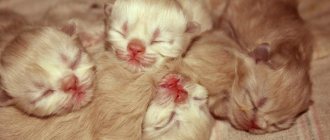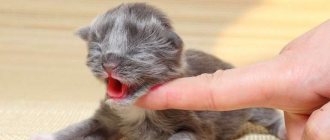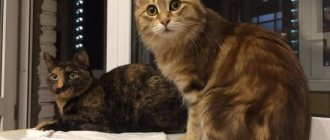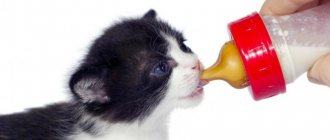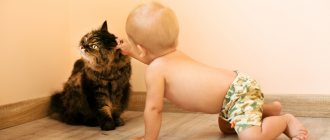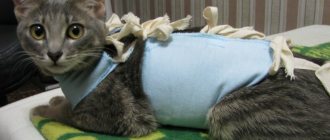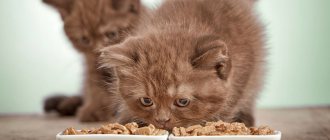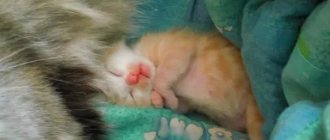What will you learn from the article?
- Kitten feeding regimen
- What foods can you feed a kitten?
- What to feed a one-month-old kitten (up to 1 month) What foods should you not feed a kitten
- Dry food for kittens
This article will help you learn how to feed your kitten correctly , calculate the diet, and avoid giving junk food.
Find out what food should be supplied to a small body in order for it to grow into a big, handsome cat.
What dangers await kittens at the bowl?
- unbalanced diet
Improper feeding affects the growth and development of the baby, leading to external defects and internal problems, and sometimes even death.
- poorly selected nutrition
The wrong choice of ready-made food, natural nutrition that causes allergic reactions - all this also negatively affects the growing body.
It is also important not to forget about a certain feeding schedule that is different from the schedule of an adult cat. Scary? Don't be shy, we'll figure it out!
When do kittens need artificial feeding?
The ideal situation is as follows: the cat cares for and feeds the kitten until it is approximately 8 weeks old. Only then can you separate the baby from his mother. But there are times when human intervention and help is required. Reasons why this may happen include:
- death of a cat;
- lack or deficiency of milk in her;
- mastitis and inflammation of the uterus in a cat;
- eclampsia in a cat, that is, calcium deficiency;
- psycho-emotional deviations of the animal.
Sometimes the mother feeds the kittens regularly, but the babies still need complementary foods. This situation may arise if the litter is very large. It happens that a weak kitten is born, which quickly gets tired when sucking - in this case, it also needs additional nutrition. How you manage to feed a kitten without a cat or simply intervene a little in the process will determine its future health.
Cat milk replacers
If the circumstances are not the best and the kitten is left without a mother, the ideal option would be to find a wet-nurse cat. If this is not possible, some alternative to cat milk will come to the rescue - its substitute. Feeding a newborn kitten is not as difficult as it seems at first glance.
Special mixtures from veterinary pharmacy
There are no organic substitutes for cat milk in nature. But today, some pet food manufacturers have created special mixtures - artificial substitutes for cat milk. They are as close as possible to the natural composition and are optimally balanced for kittens. The mixtures include many components useful for the growth and development of small pets:
- vitamins;
- minerals;
- microelements;
- Omega-3 and Omega-6 fatty acids;
- taurine
The veterinary formula is ideal for raising kittens until they are able to eat solid food on their own.
Recipes for DIY mixtures
If the price of a special mixture is too high or it is not sold in your locality, you can make it yourself - several recipes are offered.
Milk and flour
You will need 250 grams of condensed milk: always natural and twenty percent. You need to dilute it with a liter of water and add about a teaspoon of bone meal. Strain, heat and feed to babies. The mixture can be stored for no more than a day, so it is recommended to prepare it in smaller quantities. The main thing is to maintain the proportion 1:4.
With goat milk
A tablespoon of five percent glucose is mixed with goat milk, of which you will need about 1.5 tablespoons. Next, you need to add one gram of various vitamins (purchased at a veterinary pharmacy) and a teaspoon of milk powder.
Vitamin
Five percent glucose is mixed with one hundred milliliters of milk and an yolk mixed with half a tablespoon of vegetable oil is added. In the mixture you need to add Nutrilon milk baby food and a few drops of Tetravit.
Egg
A teaspoon of vegetable oil is mixed with the yolk and drops of vitamins in a proportion similar to the previous recipe.
Regardless of the composition, it is necessary to keep cat formulas in the refrigerator, and when serving, heat them to a temperature of 37 ° C. Veterinarians advise preparing complementary foods more often so that they are always fresh.
Why you shouldn't give cow's milk
When asked whether it is possible to feed a newborn kitten with cow's milk, veterinarians answer unequivocally in the negative. The composition of cat milk is very different from the milk of other animals - the amount of fat, protein and lactose varies greatly. Even adult cats do not digest goat's and cow's milk well, with their high content of lactose and fat, let alone kittens.
If you ignore the advice of veterinarians and scientifically proven facts, you can harm the baby’s health. Allergies, diarrhea, lack of essential nutrients, developmental delays - this is not a complete list of problems that can arise in a small animal when fed cow's milk. Take care of your baby's health and use special mixtures.
Recommended Products
With the appearance of teeth, the first solid food is added to the diet in addition to milk. The list of recommended products depends on the type of feeding chosen.
Industrial feed
The safest and most convenient option is ready-made food intended for kittens, pregnant and lactating cats. They have many advantages:
- save time on cooking;
- have a balanced composition;
- do not require independent calculation of the daily requirement, everything is already indicated on the packaging;
- strengthen the jaw muscles and prevent the development of tartar.
At first, you should feed your pet with heated, wet canned food in the form of a pate, a little later with meat pieces in gravy, and at the very end of complementary feeding with dry granules.
IMPORTANT!
Be sure to check with the breeder exactly what he fed the kittens. It is recommended to stick to this brand for up to a year.
Natural nutrition
Unlike industrial feeds, natural food requires daily preparation and the mandatory inclusion of vitamin and mineral supplements. Stale or improperly prepared food can lead to poisoning and parasite infestation.
When choosing “natural” foods, use liquid rice and semolina porridges, light meat broths, natural low-fat fermented milk products, pureed vegetables and minced meat. All food is pre-boiled and served in crushed form.
Forbidden food
When using industrial feed, it is enough not to buy economy-class products. With a “straight woman” everything is more complicated. Here is a whole list of prohibited products:
- legumes and white cabbage;
- corn, pearl barley and millet;
- garlic, onion and sorrel;
- bones and river fish;
- pork and lard;
- raw egg whites and chicken skin;
- potatoes and mushrooms;
- grapes and raisins;
- any products from the human table (sweets, pickles, smoked foods).
The ban also applies to whole milk. As animals grow older, they develop lactose intolerance, which can lead to abdominal pain, bloating, loose stools and nausea.
How to feed a small kitten: features and rules
There are certain rules and nuances of feeding a kitten. This applies to both the feeding regimen and procedures after it.
What things will you need?
To feed a kitten, you will have to purchase some items. A bottle with a special nipple will be more convenient for you and better for the animal: such a thing is sold in a veterinary pharmacy. It has an anatomically correct shape and resembles a cat's nipples.
You can feed newborn kittens without a cat either with a pipette or with a syringe without a needle. But this option is undesirable, since during feeding, air may enter the esophagus or milk may enter the respiratory tract, causing the animal to choke or regurgitate. It is very important to wash and sterilize items after each feeding.
Stages of the procedure
When everything you need has been collected and sterilized, dilute the mixture according to the instructions and heat it. It is not recommended to do this in the microwave - the mixture may warm up unevenly - it is better to heat it in a water bath.
Check your pet's body temperature. If the paws are cold, the kitten is cold, which means the food will be digested much worse. The baby must be kept warm at all times. To do this, place a heating pad wrapped in a towel or a bottle of hot water in his box or house.
When you are sure that the kitten is warm, you can proceed directly to the feeding process. To do this, lay a towel on your knees, carefully lay the kitten on its stomach and lift its head a little - this is the position in which kittens feed from their mother. For the very first time, you should moisten the nipple's spout with milk so that the baby smells the food and begins to eat.
How to determine if a kitten is full
Both conditions are extremely undesirable and even dangerous for a baby: underfeeding and overfeeding. If he doesn't get enough food, he doesn't gain weight well and appears lethargic. Overeating is indicated by loose stools in yellow, green and gray shades. You can visually determine whether the kitten is full in the following way: extend your finger to it. If the animal begins to suck, then it is not full.
The baby’s behavior is also an indicator. If the kitten is full, he simply turns away and falls asleep, sometimes milk bubbles come out of his mouth, if not, he squeaks, crawls and looks for a pacifier.
What to do after feeding
During the process, try your best to ensure that the animals are calmed by your voice. Talk to them and be sure to pet them, and after feeding, wipe off any remaining food from their faces.
At the end of feeding, lightly press the kitten's back against your stomach and gently stroke its tummy. With these actions you stimulate belching and start the process of digesting food.
To prevent kittens from suffering from constipation, it is necessary to massage their anus. This is done with cotton pads or ear swabs, which are dipped in Vaseline.
Artificial stimulation of peristalsis does not always help, and babies experience stool retention. In this case, you need to give an enema, but it is better to do this under the supervision of a veterinarian - leave the procedure to him for the first time, later you will learn how to give enemas to kittens yourself.
General rules
For the full development of a little pet, the owner will have to follow a number of rules. These include:
- Use only fresh and warm food. Do not store food for more than a day and be sure to warm it to room temperature before serving. The shelf life of wet canned food should not exceed 2 days.
- Mandatory division of the daily norm into several doses. Don't try to offer everything at once and put the bowl away after finishing feeding.
- Regular washing of dishes. Pathogenic microorganisms grow quickly in food bowls. Wash them after each feeding and try to use ceramic or iron products.
- A ban on any methods of heat treatment of food other than boiling.
Additional attention will have to be paid to the drinking regime and vitamins. It is best to discuss the last question with your veterinarian.
Do I need additional vitamins?
Ready-made food already contains all the necessary vitamins, so only those who eat natural food will need additional supplements. A growing body needs vitamins A, B, C, D, E and K, as well as minerals (calcium, iron, phosphorus, magnesium, selenium). Their deficiency is fraught with weak immunity, deterioration of the coat, softening of bones and teeth, impaired blood clotting and other complications.
It is important to consider the danger of not only a lack, but also an excess of vitamins. Independent selection of vitamin and mineral complexes can lead to hypervitaminosis. The brand name, dosage and duration of use should be checked with your veterinarian. The most commonly prescribed are Gimpet, Excel, Canina and Hartz.
Drinking regime
As you transition to solid foods, you will need more liquid, so purchase a separate bowl for water. Do not pour it from the tap without first cleaning it. Sediments contained in tap water are dangerous for your little pet. Also, do not forget about hygiene - wash the bowl and change the water in it daily.
If your pet eats dry granules, pay special attention to the drinking regime. Lack of fluid provokes salt deposition, which can lead to the formation of stones and blockage of the urinary ducts. If your water consumption is low, give it from a syringe or experiment with containers. Most picky cats will accept the owner's mug, large bucket-like container, or drinking fountain.
Proper and balanced nutrition is the basis of strong immunity and health. Compliance with the listed nuances and recommendations will protect your pet from a number of diseases and allow him to grow into an attractive cat.
The article is for informational purposes only. Contact your veterinarian!
Do you like the article? 155
How often should you feed
It is imperative to follow the regime and monitor the portions of the mixture. For the first two weeks, you will have to feed the kitten every 2 hours, even at night. Then the intervals are gradually shortened. After five weeks, the kitten can easily survive without food for 3-4 hours, and at night one feeding is enough for him.
At 6 weeks of age, babies feed on their own: they need to be fed up to 5 times a day and only during the daytime. Kittens grow very quickly, so the nursing period will not seem very long.
Features of the diet by month
Features of feeding a kitten aged 2 – 4 months
By this age, the kitten has already cut its teeth and it is time to transfer it to autonomous feeding, teaching it to eat and drink from bowls on its own. The kitten's growth is very active, its skeleton is being formed and strengthened, and the gastrointestinal tract is finally formed. What to feed a 2 month old kitten? The baby's diet should be as fortified as possible and especially rich in protein.
Features of feeding a kitten aged 4 – 6 months
At this age, the baby is actively gaining weight, so you need to make sure that the basis of the diet is not foods that are stored as fat, but those that increase muscle mass.
The baby's jaw has already formed and pieces of meat, beef or chicken offal can be given not ground, but cut into pieces. What else do kittens eat at this age? It is recommended to gradually add fermented baked milk or yogurt to low-fat fermented milk products.
Features of feeding a kitten aged 6 – 10 months
During this period, the daily number of feedings is actively reduced. The kitten's growth becomes less noticeable, but its taste preferences are already emerging. Do not indulge the cat's whims and do not give your teenager prohibited foods or food from the table. At this age, you can treat your pet with low-fat sea fish from time to time.
Read what should be in your veterinary medicine cabinet at home.
Calculation of daily portions
In the natural environment, a cat does not control the amount of milk her kittens eat. But since the task is to feed a kitten without a cat, certain standards must be observed. The baby quickly gains weight, but his stomach volume is very small, so feeding should be dosed. The daily intake of the mixture depends on the age of the baby. Below is the amount calculated per 100 g of animal body weight:
- from birth to day 5 – 30 ml;
- from 6 to 14 days – 38 ml;
- from 15 to 24 days – 45 ml;
- from the 25th day and over the next month - 55 ml.
These are recommended figures and may vary slightly for each breed. The daily volume must be divided by the number of feedings. The most preferable option, as for humans, is in small portions, but more often.
Natural menu
Natural nutrition is considered the most balanced.
Products for a natural diet:
- Lean meats. Veal, lamb, rabbit, turkey, and chicken are suitable for feeding kittens. The meat is given boiled, raw, in small portions, after having been doused with boiling water. Meat products should make up 80-90% of the total diet.
- Porridge . Cereals (rice, buckwheat, oatmeal, wheat) can be cooked in vegetable, meat, or fish broth. They should be well boiled. You can add minced meat, meat, vegetables, and herbs to the porridge.
- Dairy products . Kittens can be given milk, kefir, fermented baked milk, skim milk, calcined cottage cheese, natural yoghurts without dyes.
- Ocean fish, sea fish of low-fat varieties. It is given to a kitten no more than twice a week and only in boiled, stewed, baked form, after removing the seeds.
- Offal. They are introduced into the diet of kittens starting from 5-6 months. Served raw or boiled. Kittens can be fed chicken hearts, stomachs, and calf liver.
- Eggs. Once a week, offer the kitten one boiled yolk. Give raw eggs if you are confident in their quality and freshness.
- Greens, vegetables, fruits. They contain a large amount of vitamins, minerals, and beneficial organic compounds. Vegetables are given boiled, stewed, baked or raw. They are mixed with minced meat. For better digestibility, season the vegetables with a small amount of vegetable oil.
Food should always be fresh, at room temperature. After each feeding, wash bowls well with running water. Calculate portions correctly and adhere to the frequency of feedings and daily routine.
Difficulties and errors
The main and most serious mistake is a frivolous attitude towards what and in what quantities you feed the kitten. This can lead to serious problems with his health.
Pay attention to the position in which the baby eats. If you place it on its back, the mixture may enter the lungs while eating, and this often leads to death. It happens that milk comes out of the nose and the stomach swells greatly - this means that the baby has swallowed a lot of air and is trying to burp. During feeding, be sure to ensure the correct position.
If it is still acceptable to feed a kitten with a syringe at the initial stage, then experts do not recommend doing it from a spoon - such actions can lead to the fact that the sucking reflex disappears, and the baby will not be able to eat normally in the future.
Caring for newborn and older kittens
To create comfortable conditions for furry babies, you need to take care of their place of residence. A large basin or cardboard box will serve as a “dwelling”, but you will have to constantly ensure that it does not get wet. For this purpose, absorbent material is purchased that absorbs excess moisture.
In the first days of life, kittens especially need warmth, so it is advisable to install a heater near their place of residence. If you don't have one, use a heating pad wrapped in a towel or a hot water bottle. Don’t forget: the minimum ambient temperature in the first two weeks of a baby’s life is kept at 30° C. After 14 days, lower the temperature to 24° and do not change it for another three weeks.
At three weeks of age, babies begin to try to walk: be careful that they do not fall out of their nest and get injured. The first walks should take place under your watchful supervision.
Try not to let kittens onto the carpet: they do not yet know how to retract their claws and therefore constantly cling. In worst cases, the baby may be injured.
At the fifth week of life, kittens see well and move actively. Then they are introduced to the first complementary foods. By 6 weeks of age they can eat solid food, and at 8-10 weeks they can be given to new owners.
To monitor the development of kittens, you will need an accurate scale. Weighing babies is necessary for:
- calculating the volume of daily portions;
- tracking growth rates.
If your kitten is not gaining weight well, you should consult your veterinarian. Perhaps the baby is malnourished or sick with something.
Ready-made feed
There are a huge number of opinions regarding which food is better - ready-made or natural. As for industrial products, the advantages here are obvious - a complete balanced diet and ease of use. The disadvantages include the presence of synthetic food additives in some feeds.
If you have chosen to feed your pet industrial food, you should consider some rules for their use.
- Do not combine dry and wet food in your diet.
- Do not change the brand of the product.
Read the manufacturer's recommendations carefully. Starting from the age of four months, the kitten can give out the entire daily portion of dry food immediately, since kittens by this time are already able to control their appetite. Wet food should be given in portions equal to a single volume and in a heated form. In order not to harm your pet’s health, it is better to choose proven and reliable manufacturers, such as: NutroChoice, RoyalCanin, Purina, Acana. The product lines of these manufacturers include both dry and wet diets. Among the most popular brands that produce food for kittens are:
- Canadian brand "Akana". The company's products belong to the super-premium category and represent a complete, balanced diet with a low level of allergenicity. Products are made from whole, fresh raw materials of plant and animal origin. Meat component - at least 70%, the rest - vegetables, seaweed, fruits, cereals, eggs. The recipe is enriched with unsaturated fatty acids, vitamins, and microelements.
- French brand Royal Canin. The optimal content of nutrients necessary for the development and growth of kittens puts the products of this brand on a par with natural nutrition. The manufacturer recommends using the food starting from the age of four months for the kitten. The company's product line also includes a series of veterinary foods recommended for consumption based on a specific disease.

